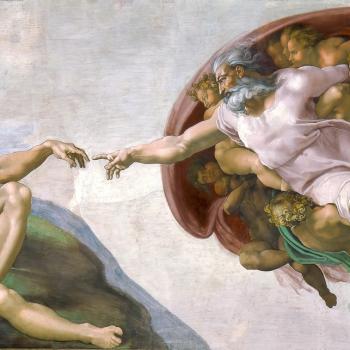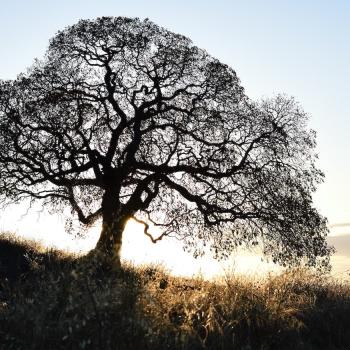A. Prologue – Plant and Animal Rituals
No teenage girl spends as much time dressing up nor more creatively embellishing her appeal than do flora and fauna. In a real Miss Universe pageant, butterflies, flowers, and birds would sweep first, second and third places – away ahead of the human contestants. Perfumes? Flowers take first place. Sexy music? Birds take first place. Costumes? Butterflies take first place. Dancing? John Travolta wouldn’t even get an honorable mention in a competition with a hummingbird.
Flowers attract their ‘meals on wheels’ – or more accurately, their ‘meals on wings’ – by painting themselves not only in the colors of the rainbow, but also using the ultraviolet and infrared ranges. And they always give a tip (nectar, pollen) to the delivery person.
Thus, do flora and fauna enact life-promoting rituals that engage the entire sensorium of the players. They coopt insects, animals and even humans in this remote mating called pollination. A Romeo offering a bunch of sweet-smelling roses to his Juliet is a B-actor attempting to mimic an Oscar winner.
So, ritual is an ancient and pervasive aspect of life on planet Earth. Let me unpack it a little more.
B. Introduction
I believe that vocalizations are one form of the language of animals, that words are the language of humans, that rituals are the language of communities, and that silence is the language of mystics. Animals have set a very high bar, especially in their mating rituals as they employ the entire repertoire of dance, feathers, colors, pheromones, and sounds.
At the human level, different kinds of ritual create different states of consciousness and give us access to different dimensions and levels of reality. Rituals, then, are both the products of existing communities and the wombs out of which new communities emerge. And I mean communities of all kinds, with all kinds of purposes, whether those purposes are for sacred or secular reasons.
C. Secular Human Rituals
Let me begin with some ancient common rituals. A gentleman doffs his cap to a lady. Maybe you saw your grandfather do it. Its origins lie in the practice of a knight in full armor and a full-head helmet raising his visor to let the lady see his face and realize he is a friend not a foe. Or the practice of shaking hands – always with the right hand. The right hand is the ‘weapon hand’ (sword, dagger…) and since 90% of people are righthanded, it’s a sign, as I offer you my right hand, that I’m not carrying a weapon and hence I’m a friend not an enemy. Of course, 10% of people are lefties, so such a one can fool you, apparently offering you his weapon hand while he holds the dagger in his left hand behind his back. Hence, in many languages the words for left and right have very different nuances. In English one of them is the ‘right’ (not the false) hand. In French, it’s ‘droit’ (hence he’s adroit at… accomplished at…) for the right and ‘gauche’ (awkward) for the left. In Gaelic it’s ‘deas’) lovely and ‘chlé (not so nice!). In Latin it’s ‘dexter’ (as in dexterous) and ‘sinister’ (well, you can figure that out on your own!)
Also very common are the rituals of hugging – placing my heart against your heart; and kissing (sharing breath, life, Spirit) with you.
At a community level, let’s take the liturgy of a Superbowl. It begins with tailgate parties outside the stadium (beer and hotdogs – the ‘body and blood’ of this particular version of Eucharist!) Then there are the particular vestments of the players – helmets, padding, face paint. Then the (hymns) chants of the ‘congregation’. And there are ‘ordained’ liturgy directors (the referees). Good ritual is always a multisensory, multimodality expression of a community.
D. Religious Rituals
Mostly, however, when we think of ritual, we think of church or religious ceremonies. So, let’s have a look at some of those. The purpose of this kind of ritual is to elevate our consciousness and go trans-rational, trans-spatial, trans-temporal, and trans-personal. Trans-rational does not mean irrational but, rather, it epigenetically includes but transcends mere mind to engage the soul. This is the big difference between knowledge (data generated by the senses and processed by the brain) and wisdom (data generated by the soul and processed by the heart.) Trans-spatial is the ability to disidentify with the merely physical and access metaphysical states. Trans-temporal means to step outside of time (you already do this every night when you are dreaming). And trans-personal means that you disidentify with your ego and re-identify with your essential nature (your soul-self.) In brief, sacred ritual is meant to induce ASC’s (altered states of consciousness) and experience mystical gnosis (personal esoteric wisdom.)
Medieval Christianity was a maestro at achieving this, particularly in the ‘high mass’ celebrated in the mystical cathedrals. Visually, there were the vestments (with different colors for the liturgical seasons), the stain glass windows (midwifing light, in its many colors), the soaring architecture (drawing the eyes to the heavens), and the statues (reminders that other mere mortals found and followed their inner divinity.) Then the nose was seduced with the olfactory invitation of the thurible-dispensed incense. And there were the Catholic versions of the mudras (body movements – joined hands, bowing, genuflecting). And there was even a gustatory level – the communion bread and wine (though the bread wouldn’t win any bakery contests and the priest kept all the wine to himself!) And, finally, there was the tactile level – touch (hugs, sign of peace – though this, too, initially was a pale symbol of a symbol of a symbol.)
E. Important Distinctions within Religious Rituals
There are some very important distinctions between signs, symbols, and sacraments. Here’s my hit on it. A sign is simply one physical thing standing for another physical thing e.g., a road sign is a piece of metal standing for a stretch of tarmac yet to be encountered. A symbol, however, has one leg in the physical and the other one in metaphysical e.g., a kiss. The physical part is the meeting of lips, the metaphysical part is the message, “I love you.” But the sacrament is a special kind of symbol that actualizes that which if signifies. Let me explain. Signs can be made to lie. A prankster can twist a road sign around 90 degrees and send you off on the wrong direction. Symbols also can lie e.g., Judas kissing Jesus in the Garden of Gethsemane. But true sacraments can’t lie. However, here’s the rub: what’s a ‘true sacrament’? A true sacrament ‘happens’ when the liturgical symbols lead to an ASC that empowers us to select out any reality by our attention and intention. So, a mindless kid approaching the altar rails to receive holy communion, with a wad of chewing gum in his mouth, is simply receiving a piece of dry bread from the priest, while a devout, inner-directed parishioner is having a real encounter with the risen Jesus.
F. The Liturgy of Daily Living
And, finally, let me look at what may be the most important sacred ritual of all. I call it, ‘the liturgy of daily living’. It is the ritual of true spirituality: the practice of turning boring routine into energizing ritual on a daily basis. It is turning your humble home into a Thin Place (in Gaelic, a Caol Áit) where Spirit parts the veil in order to flood the secular with the sacred and breathes the mystical into the merely mundane. It means turning boring routines into the liturgy of daily sacraments: your morning ablutions into a baptism; your breakfast into a Eucharistic meal; your conversations into reconciliation; your commitments into confirmation; your relationships into the marriage of soul and spacesuit; your morning awakening into an ordination rite for your Earth ministry; and your aches and pains into an anointing of the sick.
Then boredom becomes a breakthrough into the mystical mindfulness of your mission. Each dawn becomes a daily monastic bell inviting you into a renewal of your Earth vows when you enthusiastically shouted, “Here I am Lord, send me!”
It is the love-driven natural instinct of a mother who sees the breast-feeding of her baby
and the changing of its dirty diapers not as chores but as the privilege of embracing a Christ newly born.
It is activating the Michelangelo inside you to chip away the marble manacles of routine in
order to release a David or, perhaps, a Pieta.
Even reincarnation is the enthusiastic shout of the play-addicted child who pleads with the parent, “Again! Again!!”
It’s not about finishing the task but rather doing the task. It’s not about getting there but rather going there. And it’s not about the destination but rather the journey.
Before enlightenment, chop wood, carry water; after enlightenment, chop wood, carry water.
Image by Sasin Tipchai from Pixabay













